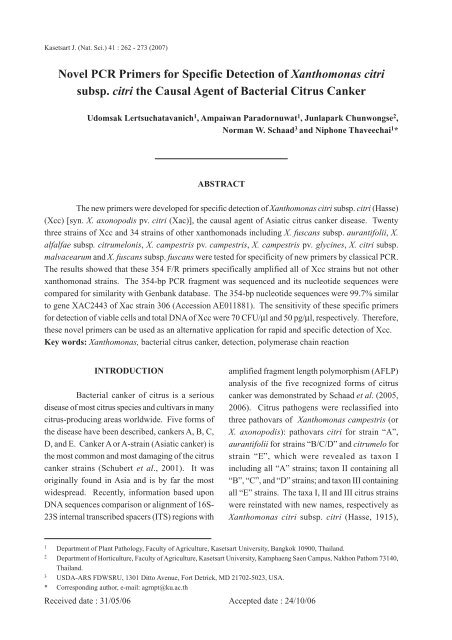April - June 2007 - Kasetsart University
April - June 2007 - Kasetsart University
April - June 2007 - Kasetsart University
Create successful ePaper yourself
Turn your PDF publications into a flip-book with our unique Google optimized e-Paper software.
<strong>Kasetsart</strong> J. (Nat. Sci.) 41 : 262 - 273 (<strong>2007</strong>)<br />
Novel PCR Primers for Specific Detection of Xanthomonas citri<br />
subsp. citri the Causal Agent of Bacterial Citrus Canker<br />
Udomsak Lertsuchatavanich 1 , Ampaiwan Paradornuwat 1 , Junlapark Chunwongse 2 ,<br />
Norman W. Schaad 3 and Niphone Thaveechai 1 *<br />
ABSTRACT<br />
The new primers were developed for specific detection of Xanthomonas citri subsp. citri (Hasse)<br />
(Xcc) [syn. X. axonopodis pv. citri (Xac)], the causal agent of Asiatic citrus canker disease. Twenty<br />
three strains of Xcc and 34 strains of other xanthomonads including X. fuscans subsp. aurantifolii, X.<br />
alfalfae subsp. citrumelonis, X. campestris pv. campestris, X. campestris pv. glycines, X. citri subsp.<br />
malvacearum and X. fuscans subsp. fuscans were tested for specificity of new primers by classical PCR.<br />
The results showed that these 354 F/R primers specifically amplified all of Xcc strains but not other<br />
xanthomonad strains. The 354-bp PCR fragment was sequenced and its nucleotide sequences were<br />
compared for similarity with Genbank database. The 354-bp nucleotide sequences were 99.7% similar<br />
to gene XAC2443 of Xac strain 306 (Accession AE011881). The sensitivity of these specific primers<br />
for detection of viable cells and total DNA of Xcc were 70 CFU/µl and 50 pg/µl, respectively. Therefore,<br />
these novel primers can be used as an alternative application for rapid and specific detection of Xcc.<br />
Key words: Xanthomonas, bacterial citrus canker, detection, polymerase chain reaction<br />
INTRODUCTION<br />
Bacterial canker of citrus is a serious<br />
disease of most citrus species and cultivars in many<br />
citrus-producing areas worldwide. Five forms of<br />
the disease have been described, cankers A, B, C,<br />
D, and E. Canker A or A-strain (Asiatic canker) is<br />
the most common and most damaging of the citrus<br />
canker strains (Schubert et al., 2001). It was<br />
originally found in Asia and is by far the most<br />
widespread. Recently, information based upon<br />
DNA sequences comparison or alignment of 16S-<br />
23S internal transcribed spacers (ITS) regions with<br />
amplified fragment length polymorphism (AFLP)<br />
analysis of the five recognized forms of citrus<br />
canker was demonstrated by Schaad et al. (2005,<br />
2006). Citrus pathogens were reclassified into<br />
three pathovars of Xanthomonas campestris (or<br />
X. axonopodis): pathovars citri for strain “A”,<br />
aurantifolii for strains “B/C/D” and citrumelo for<br />
strain “E”, which were revealed as taxon I<br />
including all “A” strains; taxon II containing all<br />
“B”, “C”, and “D” strains; and taxon III containing<br />
all “E” strains. The taxa I, II and III citrus strains<br />
were reinstated with new names, respectively as<br />
Xanthomonas citri subsp. citri (Hasse, 1915),<br />
1 Department of Plant Pathology, Faculty of Agriculture, <strong>Kasetsart</strong> <strong>University</strong>, Bangkok 10900, Thailand.<br />
2 Department of Horticulture, Faculty of Agriculture, <strong>Kasetsart</strong> <strong>University</strong>, Kamphaeng Saen Campus, Nakhon Pathom 73140,<br />
Thailand.<br />
3 USDA-ARS FDWSRU, 1301 Ditto Avenue, Fort Detrick, MD 21702-5023, USA.<br />
* Corresponding author, e-mail: agrnpt@ku.ac.th<br />
Received date : 31/05/06 Accepted date : 24/10/06
















